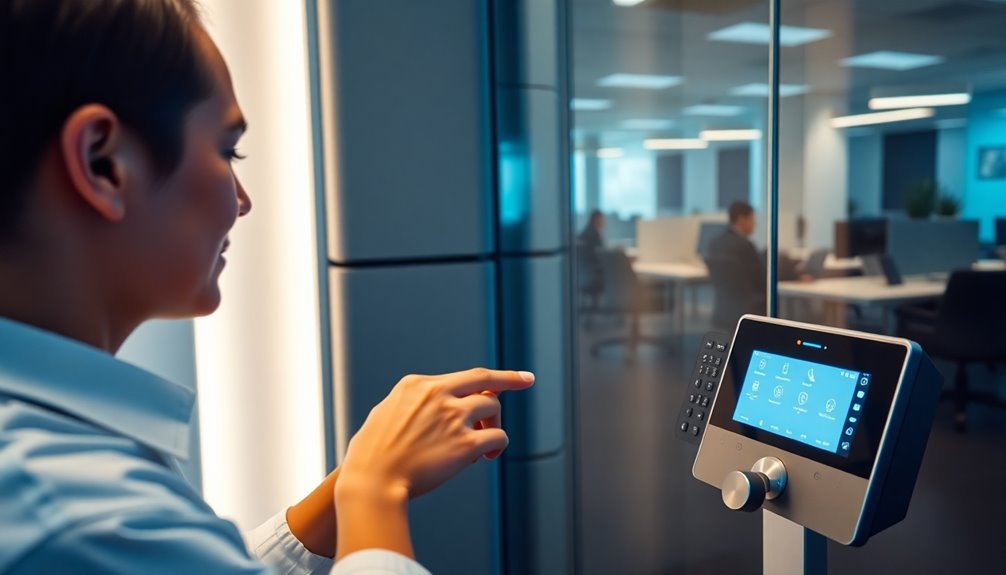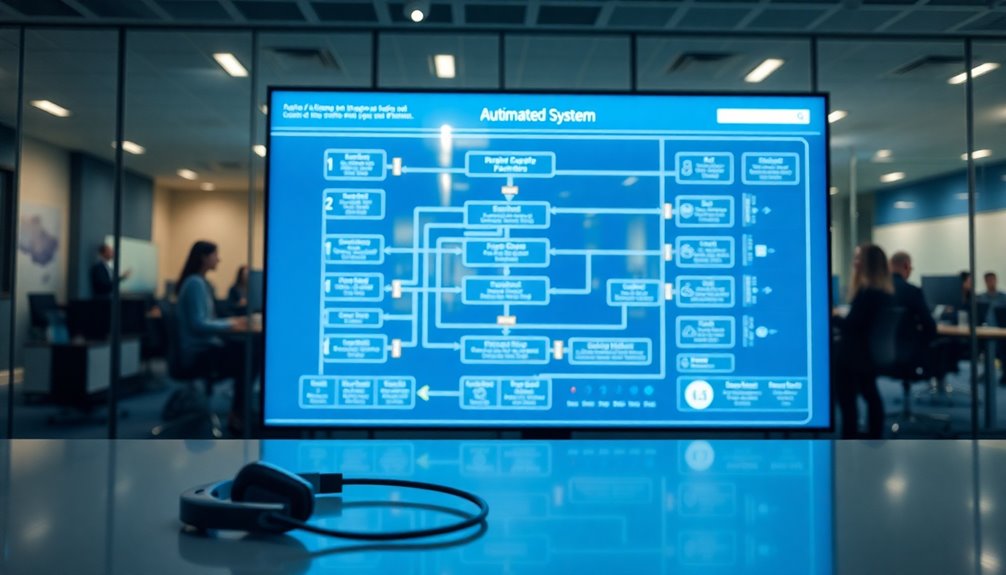An automated phone system helps you manage calls efficiently by utilizing technologies like Interactive Voice Response (IVR) and Voice-over-Internet-Protocol (VOIP). It allows you to handle multiple incoming and outgoing calls simultaneously, improving customer service and marketing efforts. With features like pre-recorded messages and call routing, these systems guarantee quick responses to caller inquiries. You can choose from various types, including outbound marketing systems and inbound support lines, tailored to your needs. If you're curious about the many benefits and applications of these systems, stay tuned for a deeper exploration of their advantages.
Definition of Automated Phone Systems
In recent years, automated phone systems have become vital tools for businesses looking to streamline their communication processes. These systems use technology to manage calls without human intervention, relying heavily on pre-recorded messages and Interactive Voice Response (IVR) to interact with callers. By implementing automated phone systems, you're able to handle multiple calls simultaneously, which enhances efficiency, especially in customer service and marketing. Additionally, regular updates to these systems can help protect against security vulnerabilities, much like maintaining software for a WordPress site. Moreover, encrypted backups ensure sensitive data is protected, which is crucial for businesses handling customer information.
Automated phone systems can be categorized into outbound and inbound types. Outbound automated phone systems place calls to deliver important messages or connect callers to live agents, while inbound automated phone systems respond to incoming calls with automated information. This call management capability allows you to maintain a high level of service without overwhelming your team.
Moreover, these systems utilize Voice-over-Internet-Protocol (VOIP) technology, allowing for quick setup and seamless integration with your existing databases. However, it's important to comply with regulations, such as the Do Not Call (DNC) list, to guarantee legal operation and maintain customer trust. Additionally, implementing an automated phone system can improve user experience by providing immediate responses to customer inquiries.
How Automated Phone Systems Operate
Automated phone systems operate by leveraging advanced technology to streamline call management, making communication more efficient for businesses. These systems utilize Voice-over-Internet-Protocol (VOIP) technology, allowing for quick setup without hardware installation. Regularly updating software maintenance is crucial to ensure optimal performance and security of these systems. Additionally, these systems often benefit from managed hosting services, which provide enhanced performance and security.
With the ability to handle multiple calls simultaneously, they employ Interactive Voice Response (IVR) to interact with callers through pre-recorded messages and prompts. Outbound automated systems efficiently handle bulk phone number lists, delivering messages or connecting callers to live agents based on pre-set criteria. When you receive a call, inbound automated systems prompt you for input, such as pressing numbers or speaking commands, to route your call or provide automated information.
These automated phone systems can detect human responses to guarantee messages reach the right audience while employing mechanisms to handle voicemail and other machine answers appropriately. This responsiveness not only enhances customer interaction but also reduces wait times, leading to a more satisfying experience for callers. By integrating these features, automated phone systems improve communication strategies, ultimately benefiting both businesses and their clients. Additionally, implementing reliable hosting providers ensures that automated systems operate smoothly, minimizing downtime and enhancing overall performance.
Key Features of Automated Systems

When you explore automated phone systems, you'll quickly notice the key features that enhance communication efficiency.
Bulk message broadcasting lets you reach many recipients at once, making emergency notifications or marketing campaigns much easier. Additionally, the voicemail drop feature streamlines your follow-up process by automatically leaving messages in voicemail boxes, saving you time and effort. Furthermore, using such systems can significantly improve user access control by managing how calls are routed and handled, ensuring smoother communication. Automated systems can also offer real-time backup capabilities to safeguard important communications and data during critical operations. Regularly testing backup functionality ensures that your automated system can recover quickly in case of an unexpected failure.
Bulk Message Broadcasting
Bulk message broadcasting revolutionizes how organizations communicate by allowing them to send pre-recorded voice messages to thousands of recipients simultaneously. With automated calling systems, you can optimize your outreach efficiency for marketing and essential notifications. This feature is especially beneficial when you need to relay urgent information, such as emergency alerts or important announcements, quickly and effectively.
You can also take advantage of scheduled calls, planning your campaigns to execute at specific times for maximum engagement. This strategic approach enhances your communication efficiency, ensuring your messages reach recipients when they're most likely to respond.
Many automated systems include voicemail drop functionality, which allows you to leave messages directly in voicemail boxes without needing an agent's intervention, saving time and resources.
Furthermore, these systems provide valuable reports and analytics. You can assess the effectiveness of your bulk messaging campaigns by examining call metrics and recipient responses. This data helps you refine future communications, making your outreach efforts even more impactful.
Embracing bulk message broadcasting can transform the way you connect with your audience, driving better results for your organization.
Voicemail Drop Feature
With the voicemail drop feature, you can streamline your communication efforts by leaving pre-recorded messages directly in recipients' voicemail boxes. This capability is a game-changer for automated phone calls, allowing you to reach a large audience efficiently without the need for live conversations.
By leveraging automated systems, you can enhance your marketing campaigns while saving time and resources.
The voicemail drop feature lets you customize automated messages based on the recipient or specific campaigns, which greatly boosts personalization and engagement. When your messages resonate with the audience, you're more likely to see improved call completion rates.
Instead of agents manually dialing and leaving messages, the automation guarantees that your intended message reaches its target swiftly and effectively.
However, it's vital to maintain compliance with regulations related to leaving automated messages. Confirming you have proper consent before utilizing the voicemail drop feature is essential for its successful and legal implementation.
Types of Automated Phone Systems
Automated phone systems come in various types, each tailored to meet specific communication needs. Outbound automated systems are designed to initiate calls, delivering pre-recorded messages or connecting recipients to live agents. You might find these useful for marketing campaigns or notifications.
On the other hand, inbound automated systems utilize Interactive Voice Response (IVR) to manage incoming calls, providing information and routing calls based on user inputs.
If you need a more versatile option, hybrid automated systems combine the features of both outbound and inbound systems, allowing for seamless communication whether you're reaching out to customers or handling incoming inquiries.
For mass communications, voice broadcasting systems are ideal, as they deliver mass voice messages to large groups simultaneously—perfect for emergency notifications or announcements.
Lastly, predictive dialers optimize call timing by using algorithms that dial multiple numbers at once, connecting only answered calls to agents. This method maximizes agent talk time, making it a great choice for customer support teams.
Understanding these types will help you choose the right automated calling service for your specific needs. Additionally, performance optimization is crucial to ensure these systems operate efficiently and effectively in handling calls.
Applications of Automated Phone Systems

Frequently, businesses leverage automated phone systems to streamline operations and enhance customer engagement. These systems play an essential role in various applications that can greatly impact your organization. Here are three key applications that you might find beneficial:
- Outbound Calls: Automated call systems enable efficient outreach through mass voice messages and automated text messages, increasing your marketing campaign's effectiveness. Implementing strong password policies can also protect sensitive customer data during these interactions. Additionally, poorly coded themes can lead to vulnerabilities that may affect the security of customer interactions.
- Appointment Reminders: You can reduce no-show rates by utilizing these systems to send timely appointment reminders, ensuring your clients stay informed and engaged.
- Emergency Notifications: When crises arise, automated systems quickly disseminate vital information to large groups, keeping everyone informed and safe.
Moreover, interactive voice response (IVR) technology allows you to gather customer feedback through pre-recorded questions, streamlining the survey process in your contact centers. Regular updates to these applications can further enhance their effectiveness and keep your communication strategies aligned with current trends.
By implementing these applications, you enhance operational efficiency while providing a better experience for your customers. Automated phone systems not only save time and resources but also help you maintain strong relationships with your clients and stakeholders.
Embracing these applications can lead to more effective communication and a more organized workflow.
Benefits of Using Automated Systems
Using automated phone systems can boost your team's efficiency by handling routine calls, so your agents can tackle more complex issues. Additionally, regular backups act as a proactive defense mechanism for your data, ensuring that you can recover quickly from unexpected events. You'll also see significant cost savings since these systems reduce the need for extra staff while managing a high volume of calls. Additionally, implementing automated solutions can lead to improved customer satisfaction by providing quicker responses to inquiries.
Increased Efficiency for Agents
The introduction of automated phone systems revolutionizes how agents manage their workload, allowing them to concentrate on higher-value tasks. By automating processes, you can increase efficiency and productivity considerably. Here's how:
- Handle More Calls: With automated dialing, you could see a 50% increase in outbound call volume, meaning more opportunities to connect with customers.
- Engage Effectively: Automated reminders and bulk messaging enable you to reach a larger audience simultaneously, enhancing customer engagement without needing extra staff.
- Data-Driven Decisions: Real-time analytics provide insights into call performance, allowing you to make informed decisions that improve service delivery.
These automated systems streamline operations in call centers, freeing you from manual dialing and letting you focus on what truly matters.
Imagine the satisfaction of handling more customer interactions while achieving a remarkable productivity boost of up to 40%.
Cost Savings on Operations
In an era where every dollar counts, automated phone systems offer considerable cost savings that can transform your operations. By utilizing automated dialing systems, you can dramatically reduce your communication expenses. These systems can handle thousands of calls simultaneously without additional personnel, cutting down on your operational costs considerably.
Many businesses see savings of up to 40% by switching from traditional manual calling methods. Furthermore, automated systems can decrease call handling times by as much as 50%. This leads to improved productivity and reduced labor costs, allowing your staff to focus on more complex tasks.
Automating routine tasks, like appointment reminders and customer notifications, not only lowers your outbound call expenses but also enhances service efficiency. Companies that adopt these systems often report a return on investment (ROI) of 300% or more within the first year. This impressive ROI primarily stems from savings on staffing and improved operational efficiencies.
Incorporating automated phone systems into your business model isn't just a smart move; it's a strategic way to streamline operations and maximize profits.
Compliance and Regulations

Steering through compliance and regulations is essential for any business utilizing automated phone systems. You need to be aware of the rules governing automated dialing to avoid costly penalties. Here's what you should keep in mind:
- Know the TCPA: The Telephone Consumer Protection Act (TCPA) prohibits calls to numbers on the National Do Not Call Registry without prior consent. Ignoring this can lead to fines up to $1,500 per violation.
- Maintain DNC List Management: Confirm your automated calls respect the Do-Not-Call (DNC) list. This practice not only protects consumer rights but also helps you avoid legal repercussions.
- State-Specific Regulations: Each state may have additional restrictions, like requiring opt-in consent for certain communications. Familiarize yourself with these to confirm full compliance.
Moreover, the Federal Communications Commission (FCC) mandates that you identify your company and provide a callback number in automated calls, ensuring transparency.
By adhering to these compliance measures, you safeguard your business and maintain a good relationship with your customers.
Choosing the Right System
Choosing the right automated phone system can greatly impact your business operations and customer interactions. Start by defining your specific goals—whether it's for customer service, marketing, or appointment reminders—to guarantee the system meets your needs.
Evaluate key features like Do-Not-Call (DNC) list management and CRM integration, as these are essential for compliance and enhanced operational requirements.
Next, consider pricing structures carefully. Basic systems might start at $20 per user per month, while more advanced solutions can cost considerably more, depending on the features you choose.
Make sure the system you select is scalable, allowing it to grow alongside your business and handle increased call volumes during peak periods.
Finally, research vendor reputation through customer feedback to gauge the reliability and effectiveness of the automated calling system.
Common Misconceptions

Many misconceptions surround automated phone systems, leading to confusion about their capabilities and effectiveness. You might think these systems can completely replace human interaction, but they actually excel at handling routine inquiries while transferring complex issues to live agents.
Here are some common myths that can mislead you:
- All automated phone systems are the same. In reality, features like voice recognition and message clarity can vary widely, affecting your experience.
- Only large businesses can benefit from these systems. Automated phone systems can be effectively deployed by businesses of any size to enhance communication and improve efficiency.
- Automated systems are impersonal. They can be customized with personalized greetings and messages, boosting customer engagement and brand recognition.
Additionally, you may assume these systems only make outbound calls, but they also handle inbound calls through Interactive Voice Response (IVR) technology.
Understanding these truths can help you appreciate how automated phone systems enhance customer interactions and streamline operations, regardless of your business's size.
Future of Automated Phone Systems
As you look to the future of automated phone systems, you'll notice that emerging technologies are driving enhanced personalization and user experience.
With regulatory compliance challenges on the rise, these systems must adapt to meet stricter standards while still offering seamless interactions.
Understanding these trends will help you navigate the evolving landscape of communication technology.
Emerging Technology Trends
The future of automated phone systems is being shaped by a host of emerging technology trends that promise to revolutionize the way businesses interact with customers. As you explore these advancements, you'll notice three key areas making waves:
- AI and Natural Language Processing: With AI, automated phone systems can understand and respond more intuitively, creating human-like conversations that enhance the caller experience.
- Cloud-Based Solutions: These systems allow businesses to scale their communication needs flexibly, eliminating the constraints of physical infrastructure and enabling seamless integration with other platforms.
- Enhanced Security Features: Innovations like biometric authentication and advanced encryption protect sensitive customer data, ensuring compliance with regulations.
Moreover, predictive analytics will optimize call timing, improving engagement rates by analyzing customer behavior.
As you embrace omnichannel communication, your automated phone systems will integrate effortlessly with SMS and social media, providing a cohesive experience.
Automated messaging will streamline interactions, ensuring your customers feel valued.
These trends are just the beginning, setting the stage for a future where your customer interactions are more efficient, secure, and personalized than ever before.
Enhanced Personalization Features
In today's fast-paced world, personalized interactions often make the difference between a satisfied customer and a lost opportunity. Enhanced personalization features in automated phone systems are revolutionizing how you connect with your customers.
With advanced caller ID customization, you can display recognizable names or local numbers, boosting call answer rates and fostering trust.
Machine learning algorithms play an essential role in analyzing caller data and preferences, allowing you to tailor voice messages and responses based on individual customer history. This means every interaction can feel relevant and personal.
By integrating your automated phone systems with Customer Relationship Management (CRM) systems, you gain access to real-time customer information, which enhances dynamic message personalization during calls.
Text to Speech (TTS) technology further elevates this experience, enabling you to create personalized messages on-the-fly without relying on pre-recorded audio.
Additionally, advanced analytics tools provide insights into customer interactions, helping you refine and improve your messaging strategies. This ongoing evaluation guarantees that your customer experience continually evolves based on feedback and engagement metrics, making every call a unique opportunity for connection.
Regulatory Compliance Challenges
Maneuvering the complex landscape of regulatory compliance can feel intimidating for businesses utilizing automated phone systems. You have to navigate a maze of laws while ensuring your operations remain lawful.
Here are three key challenges you might face:
- Adhering to the Telephone Consumer Protection Act (TCPA): You must obtain prior consent from consumers before making automated calls, or risk hefty fines.
- Compliance with the National Do Not Call Registry: Calling numbers listed here without permission can lead to severe penalties.
- Understanding state-specific regulations: States may impose additional restrictions on robocalls, complicating your compliance efforts.
Moreover, the FCC requires clear identification of the caller and the purpose of the call, enhancing consumer awareness. Ignoring these regulations can result in significant legal repercussions, including penalties that can reach thousands of dollars per violation.
It's essential to stay informed and proactive about regulatory compliance to protect your business from the pitfalls of telemarketing calls. By prioritizing these challenges, you not only safeguard your operations but also foster trust with your consumers.
Best Practices for Implementation

When implementing an automated phone system, prioritizing user experience should always be at the forefront of your strategy. Start by designing intuitive IVR menus with clear options to reduce customer frustration and enhance call navigation efficiency. This guarantees that callers can quickly reach the information they need.
Regular training sessions for your staff are essential. Familiarizing them with the automated system features will optimize their communication effectiveness and help them assist customers more efficiently.
Additionally, utilizing data analytics to monitor call performance and gather customer feedback is vital for continuous improvement. This data will help you refine processes and functionalities.
Don't overlook compliance with legal regulations, such as Do-Not-Call lists. Adhering to these standards not only maintains ethical practices but also protects you from potential fines or legal issues.
Before full deployment, thoroughly test the system to identify and resolve any technical issues. This proactive approach guarantees seamless operation and reliability from day one.
Conclusion
In a world where communication is the lifeblood of business, automated phone systems are like the heartbeat that keeps everything running smoothly. By understanding how they work and choosing the right system, you can enhance efficiency and customer satisfaction. Don't let misconceptions hold you back; embrace these tools to streamline your operations. As you move forward, remember that investing in automation is like planting seeds for growth—nurture them, and you'll reap the rewards in no time.


